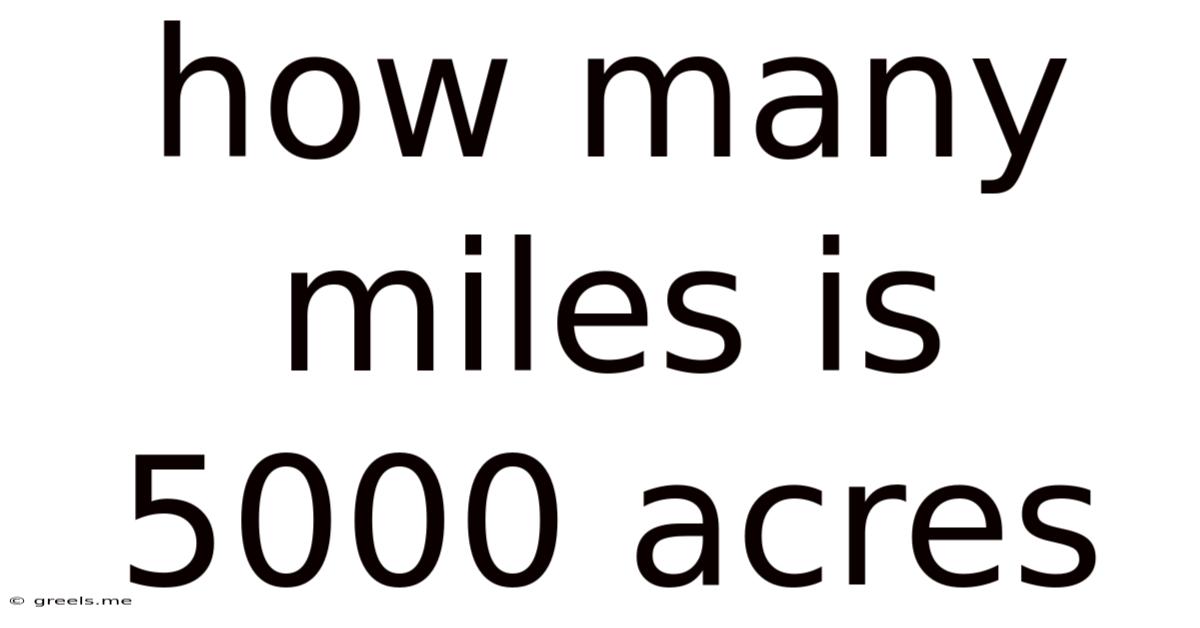How Many Miles Is 5000 Acres
Greels
May 23, 2025 · 5 min read

Table of Contents
How Many Miles is 5000 Acres? Understanding Land Measurement and Area Calculations
The question "How many miles is 5000 acres?" isn't straightforward. Acres measure area, while miles measure distance or length. You can't directly convert one to the other without knowing the shape and dimensions of the land in question. This article delves into the complexities of land measurement, explores the relationship between acres and miles, and provides methods to estimate the possible linear dimensions of a 5000-acre property.
Understanding Acres and Miles: A Fundamental Difference
Before we attempt any calculations, it's crucial to grasp the difference between acres and miles.
-
Acres: A unit of area measurement, typically used for land. One acre is approximately 43,560 square feet. Think of it as the size of a football field.
-
Miles: A unit of linear measurement, representing distance. One mile is 5280 feet. Think of it as the distance you might walk or drive.
Trying to convert acres directly to miles is like trying to convert square feet to feet – it doesn't work without additional information. A 5000-acre property could be long and narrow, or short and wide, significantly affecting its linear dimensions.
Calculating Possible Dimensions of a 5000-Acre Property
To understand the possible “mile-equivalent” of 5000 acres, we need to consider different shapes. Let's explore a few scenarios:
1. A Square Property:
If our 5000-acre property were a perfect square, we could calculate the length of one side using the following steps:
-
Total area: 5000 acres = 217,800,000 square feet (5000 acres * 43,560 sq ft/acre)
-
Side length: √217,800,000 sq ft ≈ 14757 feet
-
Side length in miles: 14757 feet / 5280 feet/mile ≈ 2.79 miles
Therefore, a square 5000-acre property would have sides approximately 2.79 miles long.
2. A Rectangular Property:
Let's assume a rectangular property. We can create numerous scenarios with different length-to-width ratios. For example:
-
Scenario A: Long and Narrow: Imagine a rectangle with one side of 1 mile (5280 feet). To find the length of the other side:
- Area = Length x Width
- 217,800,000 sq ft = 5280 ft x Width
- Width ≈ 41250 feet ≈ 7.8 miles
This would result in a rectangle with sides of approximately 1 mile and 7.8 miles.
-
Scenario B: More Square-Like: Let's aim for a more balanced rectangle with a length twice the width.
- Let the width (W) be x. Then the length (L) is 2x.
- Area = L x W = 2x * x = 2x² = 217,800,000 sq ft
- x² = 108,900,000 sq ft
- x ≈ 10435 feet ≈ 1.97 miles (width)
- 2x ≈ 20870 feet ≈ 3.95 miles (length)
This yields a rectangle with approximate dimensions of 1.97 miles by 3.95 miles.
3. Irregularly Shaped Property:
Most real-world properties aren't perfect squares or rectangles. Their shapes can be highly irregular, influenced by natural boundaries like rivers, mountains, or roads. In these cases, precise calculations become more complex, often requiring surveying techniques and specialized software. However, the total acreage remains a constant.
Beyond Simple Geometry: Factors Affecting Linear Distance
The simple geometrical calculations above give a basic idea. However, the actual distance you'd travel across a 5000-acre property depends on several factors:
-
The Shape of the Property: A highly convoluted property will require significantly more travel distance than a compact one, even if the acreage is the same.
-
The Purpose of Measurement: Are you measuring the perimeter (the distance around the property's edges), the longest diagonal, or the average distance from one point to another? The answer will vary greatly depending on the specific metric.
-
Terrain: Uneven terrain, hills, and obstacles will increase the actual distance traveled compared to a straight-line measurement.
-
Roads and Access: The presence of roads and access points will influence how one traverses the property.
Practical Implications and Applications
Understanding the relationship between acreage and linear distance is crucial in various contexts:
-
Real Estate: Buyers and sellers need to understand not just the acreage but also the practical dimensions and accessibility of a property. A large acreage might seem appealing, but its shape and accessibility can influence its usability.
-
Agriculture: Farmers need to calculate distances for planting, harvesting, and equipment movement across their fields. Knowing approximate distances is vital for planning efficiency.
-
Conservation and Environmental Management: Protecting and managing large land areas requires understanding distances for patrolling, monitoring, and implementing conservation efforts.
-
Development and Infrastructure: Planning new infrastructure (roads, pipelines, etc.) necessitates careful consideration of distances and the overall layout of the land.
Advanced Techniques for Irregular Properties
For complex, irregularly shaped properties, more sophisticated methods are required:
-
Geographic Information Systems (GIS): GIS software can analyze digital maps and determine precise areas, perimeters, and distances within a property.
-
Surveying: Professional land surveyors use advanced equipment to precisely measure boundaries and generate detailed maps, which can be used to accurately calculate distances.
Conclusion: It's More Than Just Numbers
The simple answer to "How many miles is 5000 acres?" is: It depends. It depends on the shape and configuration of the land. While we can estimate possible linear dimensions using simple geometry for idealized shapes, the real-world application is much more nuanced. Understanding the limitations of simple calculations and the role of factors like shape and terrain is crucial for accurately interpreting land measurements and making informed decisions. For precise measurements of irregularly shaped properties, professional surveying and GIS techniques are necessary. However, the fundamental understanding of acreage and its relationship to linear distance remains vital in various applications.
Latest Posts
Related Post
Thank you for visiting our website which covers about How Many Miles Is 5000 Acres . We hope the information provided has been useful to you. Feel free to contact us if you have any questions or need further assistance. See you next time and don't miss to bookmark.